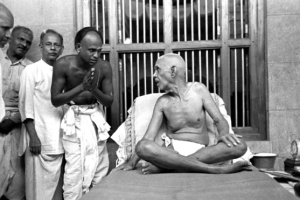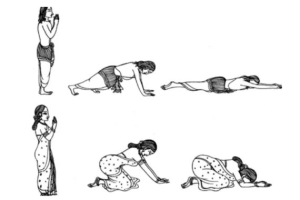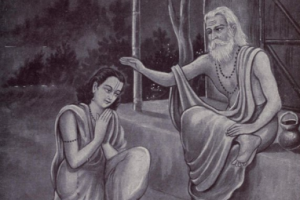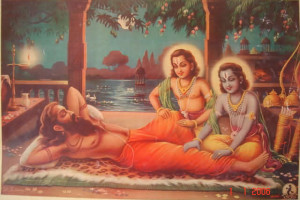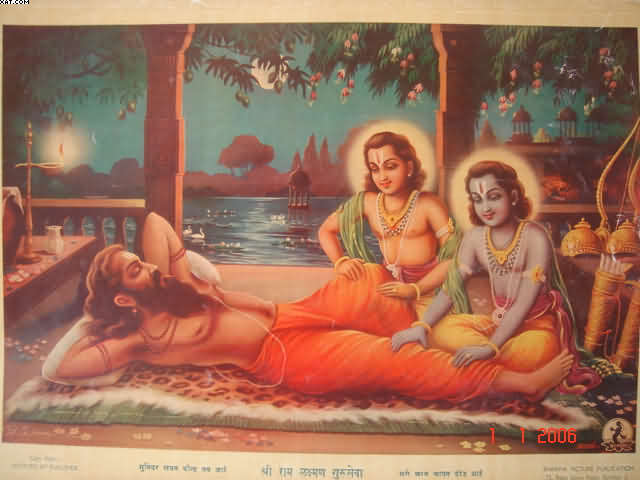Guru-Shishya Series-1: Introduction & Approaching the Guru
22 December 2022
Houston, Texas
Over the past 2-3 days, the subtle pressure to compose this article is building up, so I am compiling this to relieve the subtle pressure in my head. I resisted writing this article as it could be indigestible or inappropriate to western societies or minds. I still write as a recording.
The distinction between Religious system/ Sect (sampradaya) & Lineage (parampara):
Let's define these 2 terms:
- Sampradaya (Sect) is a Sanskrit word that refers to 'tradition', 'spiritual lineage', 'sect', or 'religious system'
- Parampara (Lineage) is a Sanskrit word that refers to the succession of knowledge from one guru to the next. Literal Meaning: parampara means something like “uninterrupted series,” "continuation," or "succession."
So, there could be one main sect and several sub-sects under it, each sub-sect will have several lineages and sub-lineages under it. That's how the tree grows down into several branches from one main deity or originator on the top.
Eg:
Here, 2 such examples are given of 2 different sects are given. This also applies to Buddhism and other religions.
- Sect: Vaishnavism or Vaiṣṇava- sampradāyaḥ (Ultimate Deity: Lord Vishnu/ Krishna)
- Sub Sect: Brahma Sampradaya (Sponsor Deity: Brahma)
- Sub-Sub Sect: Madhva Sampradaya (Main Preceptor: Madhvacharya)
- Lineage: Pithadhipatya Brahma-Madhwa Guru Parampara (Sage: Raghavendra Tritha)
- Sub-Sub Sect: Madhva Sampradaya (Main Preceptor: Madhvacharya)
- Sub Sect: Brahma Sampradaya (Sponsor Deity: Brahma)
- Sect: Shaivism or Śaiva-sampradāyaḥ (Ultimate Deity: Lord Shiva)
- Sub Sect: Nath Sampradaya (Sponsor Deity: Adi-Nath (Shiva))
- Sub-Sub Sect: Nandinatha Sampradaya (Main Preceptor: Maharishi Nandhi-Nath)
- Lineage: Kailasa Parampara (Sage: Thirumoolar, Vyaghrapada, etc)
- Sub-Sub Sect: Nandinatha Sampradaya (Main Preceptor: Maharishi Nandhi-Nath)
- Sub Sect: Nath Sampradaya (Sponsor Deity: Adi-Nath (Shiva))
Generally, a student will adhere to one lineage (parampara) over several lives. By fate or providence or deity's wish and grace, a student might be in more than one lineage in one or over several births.
There are also exceptions and examples of several great beings like Sanatkumaras, Narad muni, Madhva whose name can be seen in more than one sampradaya, their names appear in both Nath Sect and Vaishnavite Sect.
4. Tenets of Guru-Sishya relationship: (Teacher-Student Relationship)
Guru is a Sanskrit word (गुरु, ˈɡo͝oˌro͞o) meaning "Dispeller' Destroyer of Darkness". The root words are "gu" meaning darkness and "ru" meaning destroyer or dispeller. Guru here means Spritual teacher who dispels the spiritual ignorance of the student.
Sisshya is a Sanskrit word (शिष्य, śiṣya) that means disciple, student or pupil.
4 key tenets in that relationship:
- Diksha (initiation)
- Shiksha (transmission of knowledge)
- Guru-dakshina (Obligation or fee to the Teacher)
- Guru gotra (Guru or Lineage Surname)
1. Diksha (initiation):
-
- Astral or ceremonial initiation into a particular lineage (parampara) of a sect (sampradaya) into a practice.
- A recognition of the relationship where the guru accepts the initiate as a shishya (student) and also accepts responsibility for the spiritual well-being and progress of the new student.
- This responsibility can extend over one to several lives or until one transfers the burden of responsibility to another lineage teacher's shoulder.
2. Shiksha (transmission of knowledge):
- This initiation (Diksha) process will include the conveying and transmission of that lineage's specific esoteric wisdom, philosophy, Yogic, meditation methods & techniques with Grace astral energy to practice it.
- This transmission can happen only from top to bottom, like how water flows from higher potential or altitude to lower potential or altitude. Clearly, the student has to be submissive to the teacher and held him at a higher spot. Shoulder-to-shoulder relationships with teachers might slow down the transmission not due to lack of teacher's power but to in submissiveness attitude and it's psychic obstruction of the student

3. Guru-Dakshina (Obligation or fee to the Teacher):
- Where the student is indebted to the guru (teacher) for his teaching services and has to pay back as per Guru's terms and conditions.
- In ancient times, students used to live with teachers in the forest by building huts nearby the teacher's huts and undergoing rigorous training from the sage.
- Like Lord & Prince Rama, the God Incarnation himself went to his teacher place Sage Vasistha (7th Manu) to be tutored and stayed with him from 8 to 16 years, for almost 8 years in a deep forest. Unlike in modern times, teachers did not go to students' homes to tutor them.
- The fee or obligation to the teacher and his family would be a:
- Simple fruits, forest foods, gathering woods for fire, water from the river and washing the guru's clothes in a nearby river, massaging the guru's feet, and doing other household chores.
- There was also examples of serious askings from the teacher at times:
- Great Sage Vishvamtira took Lord Ram at the young age of 24 from his father for 10 days to teach Rama and Lakshmana the divine warfare with his collection of astral weapons and in return he wanted them to kill the demon Tadka and to protect his night-long sacrificial fire penance from Demon's interruption and illusions.
- Ekalvya must be one of the earliest long-distance or online students. He learned all martial warfare skills from Dronacharya by making a clay statue from Dronacharya's feet mud, without his physical presence.
- When Drona came to know of his skills, Drona asked a heavy Guru-dakshina (obligation) from Ekalavya which was his right thumb. The whole archery revolves around the right thumb, it was specifically asked to handicap Ekalvya's extraordinary skills which were on par with Arjuna's.
- This was due to the complex fate of the promises and vows he made to Bhishma and Arjuna, that he would teach only to Kuru Dynasty's Aristocratic warriors and promised Arjuna to make him the best archer in the world.
- The fee or obligation to the teacher and his family would be a:

4. Guru gotra (Guru or Lineage Surname):
- There are 2 births for a spiritual seeker or student.
- The first birth is the physical birth from his or her's biological father
- The second birth comes from the spiritual father who initiates (diksha) into the spiritual path (Jnana) and removes the veil of spiritual ignorance (avidya).
- This refers to the practice of adopting the name of the spiritual guru or the parampara as one's gotra (surname) instead of gotra at birth.
- The disciples of the same guru, especially in the same cohort, are referred to as guru Bhrata (brother by virtue of having the same guru) or guru bhagini (sister by virtue of having the same guru).
- Now, once the name of the guru gotra or lineage is given or loaned, the student has far wider and greater responsibilities, duties, and the burden to uphold the high value and the virtues of the respective Guru. Certain lineage energy comes with it for doing the spiritual practice (sadhana), it which should not be misused or used whimsically for non-prescribed activities.
- If one deviated from the prescribed spiritual path, the student can be easily thrown out of the lineage or barred for 10s of thousands of years, just like that. (I was in that border line situation, I was barely saved by Madhva).
The first 2 tenets (Initiation (Diksha) and transmission of Knowledge (Shiksha)) are in the discretion of the teacher and the teacher shares a major portion of the responsibilities; of course, the student's part is there, one has to cooperate and be submissive to the will of the teacher.
The last 2 tenets (Obligation/ fee to the Teacher (Guru-Dakshina) and Teacher or lineage Surname (Guru gotra)), completely belongs to students. For the rest of their life, the student has to pay the obligation to his teacher and one the gotra name transferred has even more obligations and responsibilities added to the list.
Adding no blemish to the given lineage's surname is itself a big success, if one can add more value to the given lineage name, it is even greater.
My Experience:
So, several of this information and the practice given here are very rarer even in this modern times of Indian culture but it is still practiced in remote areas and by serious practitioners with rigor.
Lord Rama and Lord Krishna instruct the students to pay their due respects to their spiritual teachers who are indirectly empowered by their grace.
Guru's Wooden Sandals (Sanskrit word: Padukas)

Astrally, when Is treated yogic practice without any physical teacher present by the side. these were some of the practices followed from my previous life's remnant energy in my psyche when I was astrally instructed to do the breath infusion practice from Madhva's youtube video.
In the following days, certain astral practices automatically transpired. Sitting near the river, under a tree, keep the Guru's wooden sandals on top of my head, paying due respects.
This has been my attitude (Sanskrit: bava) till today. It is not a prayer nor a lip service, it is a spontaneous emotion or feeling towards all my gurus in this life and over several lives. This code indeed has been in my subtle body over lives, it did not come from my parental or societal, or cultural training!
I am not even comparable to the mere dust of my guru's feet
I am not even worthy of his mere glance over me
Nor even worthy of his accidental touch by his feet nor his wooden sandals
Having said that what a grace that he lets me put his padukas over my head!
Boundless Grace!
How will I hold myself to the standards of thy wooden sandals!
This is where I have to be!
Lower!
That is where you have to be!
Higher!
Always!
There are such people in India who give such respects to the teacher, but the numbers are very scarce, I have seen quite a few in my life. Genuine ones showing genuine respect to the teacher will not pose for camera nor ashram nor establishment sake nor political influence sake or reputation sake.
This could be a shocker to western civilization and rate it as servitude or slavery to the teacher; yes, it is indeed the right word to describe. Except for the connotation here is different!
It is a voluntary servitude and slavery with a heart filled with gratitude to even allow such a high companionship or stand under the superior soul's shadow for such a low life.
The only major difference here is in the realization and conviction that the student and spiritual teacher are not in the same category!
The teacher is Higher & the student is lower! Once this realization or spiritual fact is established with self-introspection of the student's spiritual limitations, the remaining servile attitude automatically ebbs and flows by the grace of the teacher!
I recently found this picture were a similar practice of placing the Guru's padukas (his Tibetan master) on head by TK Krishnmahcarya, a renowned yogi (teacher of BKS Iyengar) (1987).

Good teachers vs Bad Teachers:
All of the above is relevant only to "True Spiritual Teacher or Jnanis".
How to find a True spiritual teacher? There are several standards set by several teachers and scriptures. Something, I like the most which is relevant in modern times is the one said by Nisargadatta Maharaja (a true jnani, self-realized person) to David Goodman in the 1970s.
David Goodman asks: "Why are there so many bad teachers"?
Nisargadatta Maharaj responds: "Bad teachers are as important as Good teachers"
David Goodman yells: "Whatttt!"
Nisargadatta Maharaj: "Haha, Let me explain to you! How big is this room, the one we are sitting in now? Maximum, it could hold 30-35 people. What happens if all of them want to reach learn spirituality and fill this room Bad teachers attract bad students and save the mayhem for the good teachers. Imagine how can we sit together and talk like this if millions throng to see me"
This is a true statement. Bad students attract bad teachers and both deserve each other. Bad students like power-craving people and mercantile people are attracted to simailr bad spiritual teacher, not for liberation instead for mercantile gains or more political influence or status symbols, and accordingly, the bad teacher ignorantly lead them to even more materialistic entanglements and many times to good material gains too
When one so-called spiritual teacher decides to use "Shri" behind his name to describe his brilliance, ("Shri" in Sanskrit means resplendence and auspiciousness) and suddenly in the mid way he thinks just one "Shri" is not enough to describe his radiance and brilliance, now he decides to use "Shri Shri". How magnanimous! Even deities or Paramatma or Gods have only one Shri to describe their immeasurable radiance. But still one is not enough to describe his radiance!
This name aggrandizing is nothing when compared to this other so-called spiritual teacher, he just uses 1-word next to another powerful word. But when they are combined, they mean ultimate or all-pervading teacher!
The Sat in Sanskrit means absolute spiritual truth, spiritual reality, the parallel cosmic manifestation of the Cosmic form of Krishna. Now, when someone combines Sat with Guru, that means he is the guiding force or the absolute teacher of the manifested & unmanifested reality.
Some schools of Advaita philosophy which is totally different system with wandering monks living in scanty food with no or little clothes or living a low-key life utter such maha tattva statements like "I am that" or "I am Brahman" to the self but they lived outside the society or silently inside the society. They did not make an institution to suck out hard-earned people's money to build an empire.
Once the true Janani or self-realized teacher is found by the grace of providence, one who is worthy of all the respects given here to him.
All these are natural bhava or attitudes, this comes naturally once they realized how fortunate they are to see an enlightened soul in a physical body in these low dimensions.
- Visiting the teacher:
- The student should not sit equally with the teacher.
- The teacher should sit elevated, and the student on the ground
- Or if the teacher is sitting in the chair, the student should be standing unless th teacher permits him to sit
- The teacher should lead the way, the student should follow the teacher and stand behind the teacher all the time
- Student touches the food only after the teacher tastes the food.
- On seeing the teacher in the morning, the student prostrates and touches the feet of the teacher and while leaving or retiring at the end of the day, the student again prostrates before the teacher and takes permission to leave!
- There is a 3000-year-old aphorism in the Tamil Language that says what is the point in having a head above the shoulders which do not bow to enlightened souls or God,
- Do not beam the chest in front of the teacher, the body posture has to be bowing down in front of the teacher while talking to a teacher or Janani (as shown in the picture, how a disciple bows to Ramana Mahrishi).
- The student has to treat the women in the teacher's house and the family has his own mother and sister.
- Should not call the teacher by first or last name, need to be addressed as "Teacher", "Master" or "Guruji"
- Any insulting or unpleasant scenes that happened to the guru due to circumstance, one should turn the face away from viewing those scenes. (Looking away avoids any involuntary laughing or smirking and also a registry of such incidents in the psyche)
- The student should not sit equally with the teacher.
- Talking to Teacher:
- Bowing down, cover the nose and mouth with 2-3 fingers of the right hand while talking to the teacher; the breath, saliva, or any bad breath should not touch (even accidentally) the physical body of the teacher.
- Talk in a lower tone, the decibel should not be higher than the teacher's voice.
- Even while arguing or asking questions, the argument has to be rephrased in such a way that it is always polite and not trying to corner the true spiritual teacher, with no insinuations or subtle attacks on the teacher! No critical energy should be directed to the teacher!
- Insults from the teacher are blessings, if it is painful and sharp, the student should look at the ground and repent or suffer the pain. At no point should one look into the eyes or stare down the teacher.
- The teacher makes a great favor by bringing out the defect unknown to the student's psyche, the insult can be extremely painful, it should make one feel very embarrassed. The student can't face his teacher again and looks down at his feet or ground until he asks you to look at his face, one should not be looking at his face shamelessly with a "so what" attitude!
- When the teacher appreciates or praises the student, the student should shut the ears, feel shy and humbly give back the compliments respectfully as it is just a mere extension of his grace.
- Because even such compliments can spike the dormant arrogance in a student's psyche and be a thorn in his relationship with his teacher and his learning. The highest compliment is the relationship, what more compliment one needs from the teacher?
- Obligations of the teacher:
- Whatever obligation the teacher asks for should be paid diligently to the teacher. If the obligation is to practice regularly or to write down or be tasked with some other mission or assignment, the student has to faithfully discharge.
- There should be any doubt in this, if one cannot do what the teacher asks or requires, what is the point of being with the teacher? The teacher may act like he is ignoring on the physical side, in fact, he has made a note, or astrally any time the teacher can check out the past records easily, everything is recorded in detail.
- Whatever obligation the teacher asks for should be paid diligently to the teacher. If the obligation is to practice regularly or to write down or be tasked with some other mission or assignment, the student has to faithfully discharge.


This is left as a recording, in western society and western culture many of them can't be practiced. There is also a saying "Be a Roman in Rome". In close quarters with a guru, how much ever he permits or how he relates to each student differs accordingly and the above-mentioned respects can be paid.
The external physical acts are just the manifestation and consequence of the inner respect and attitude to the teacher. If the inner attitude is fixed, whether the external acts do or do not matter is left to the student-teacher discretion and their relationship. If inner attitude is bad and covetous, however elegant the external acts may be, how does it help one? In all the above-mentioned respects, even though it is targeted toward the teacher, the teacher has nothing to gain nor affect him. The biggest benefactor is the self, the student. It tunes the subtle body and gives immunity to conceit and arrogance toward teachers to a good degree.
Whenever I see an insult thrown or guru sitting down in front of others or guru washing my eaten plates, I wonder what sin I must have committed in past lives to witness such scenes or even hear or see such untoward incidents against him. I must have had traces or loads of defiance to my teachers in my karmic list if not I would not be exposed to such incidents in front of a true jnani or enlightened. I am already fearing what astral carp behavior has my subtle body already displayed in front of him.
Pardon me, if it sounds regressive or untenable to the reader's mind. I am relieving my psychic burden by composing this article, I resisted this article, especially for the western audience but higher forces overpowered me to compile this.
-
- · Rishabha
- ·
Very much appreciated and valued article. Thank you very much for sharing
-
- · Michael Beloved
- ·
Interesting description/summary of the guru concept in India.

